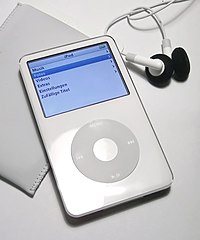Ipod Classic 6th Gen
During a special iPod-centric event on September 5, 2007, Steve Jobs introduced the sixth generation iPod and the retronym suffix "Classic". Featuring slightly thinner bodies, the sixth generation Classic also sported dramatically improved battery life, claiming up to 40 hours of music playback and 7 hours of video playback. The front plate of the iPod is now made of anodized aluminium instead of polycarbonate plastic, and "Signature iPod White" has been replaced by silver. This means that it is the first time that white is not a color option for any iPod in the iPod family. The sixth generation Classic also introduced a completely overhauled user interface, incorporating more graphics and Cover Flow. The sixth generation Classic was offered in an 80 GB (20,000 songs) model for MSRP US$249/GBP£159 and a 160 GB (40,000 songs) model for MSRP US$349/GBP£229. The U2 special edition has been dropped.
During the Let's Rock Apple Event on September 9, 2008, the 80 GB and the thicker 160 GB model were discontinued in favor of a thin 120GB version retailing for US$249/GBP£179.
Acoustics issues
According to certain tests performed both by hearing and through computer analysis of the sound, the 6th Generation iPods lack sound quality in the mid range, and produces less spatial information (i.e. stereo sound plays 'inside your head' instead of 'outside') due to higher impulse in the treble compared with 5G.Apple has not yet commented on this problem.
A firmware update, 1.1.1, released by Apple for the iPod Classic is said to, among other things, improve the sound quality. However, no details on these improvements were given on the Apple website.
Another later update, 1.1.2, is shown to correct bug fixes, but is nonetheless another minor update.
Software issues
The first batch of sixth generation iPod Classics have been reported to crash trying to load album art and connecting to iTunes after syncing for the first time. Some people also have reported that browsing through Cover Flow, playlists and navigation is sluggish.Windows Vista users also have to download Windows Updates to fix the syncing problems. iPods of the 6th generation (as well as the iPod Nano and the iPod Touch) introduced an additional checksum in their song database, making it initially impossible (without reverse engineering) to use the iPod with 3rd party syncing programs. This limitation was soon worked around by Gtkpod, MediaMonkey and Sharepod teams.
Since its release, the iPod Classic has also suffered from an On-The-Go playlist bug that occurs when users attempt to add songs to the end of the playlist once the playlist has started playing, rendering the "On-The-Go" aspect of this function effectively unusable





